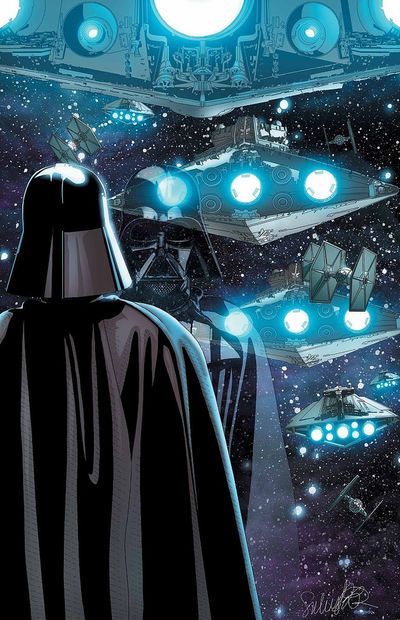In Kieron Gillen and Salvador Larroca's "Darth Vader" #9, the Dark Lord of the Sith continues to gather resources that will help him find the rebel he now knows to be his son, but his mission has been complicated by the presence of an Imperial investigator assigned to uncover the truth behind Vader's own covert actions. The middle segment of Gillen's second arc for the title drags a bit, as Vader largely has what he needs to undertake his personal mission but is now required to mostly follow along as Inspector Thanoth gets closer to finding out the truth. The twist Gillen introduces is a clever one, but it also serves as much as an impediment to the overall plot as much as an enhancement, slowing the story and unintentionally diminishing Vader's presence as a genuinely imposing character.
In making a title like this work, Gillen has had a tough mission of his own and, for the most part, has succeeded so far. However, as a lead character, the almost all-powerful Dark Lord needs to be put in a position of weakness in order to eventually triumph, and that's a position not always well-suited to the character's persona. The motions Vader goes through under Gillen are really no different than those first seen in "A New Hope," as he follows the command of another and uses fear to intimidate those he seeks information from. In the original movie, Vader was in a position of strength and dominance as a deadly and intimidating presence within the Empire's vast reach. Here, though, Vader is at odds with his masters and, while it's an intriguing situation for Vader to be in, it just doesn't carry as well as the domineering Vader known to most "Star Wars" fans.
Gillen's story works better at a micro-level, though; the dynamic between Vader and Thanoth is tense, as there's an underlying sense of distrust between the two men that Gillen conveys implicitly through their ongoing dialogue, and this interaction serves as the highlight of the issue as well as for both characters. With little else for Vader to do, though, Gillen opens the issue with a somewhat contrived and oft-seen sequence of Vader dispatching a group who, of course, underestimate his powers and pay the usual price for it. There's really no connection to the rest of the story, despite Gillen's attempt to force one later on with a subsequent reference.
Larroca, however, is as strong as ever with his crisp lines and uncluttered layouts, rendering both characters and machines with clarity and precision. He stretches his artistic legs with the former early on, giving "Star Wars" tech geeks a reason to pause their reading in order to study the detailed array of ships shown in a full page splash. Larroca's interpretation of the mutton-chopped Thanoth is refreshingly different from the typical Imperial officers seen in the various comics over the years, and his take on Vader himself is faithful to the character's iconic appearance, which is decidedly threatening as envisioned.
Larroca's excessive usage of shadows -- used to both establish a dark and foreboding mood for Gillen's story as well as a fitting texture for Vader's helmet and cape -- has never been more appropriate. The blackness of Vader's form and the abundance of Stormtrooper white don't give colorist Edgar Delgado much room to maneuver, but he doesn't really need it as the rest of his colors are mostly subdued, earthy tones that don't really draw much attention.
"Darth Vader" #9 doesn't fully do justice to one of cinema's most recognized villains, but Gillen still crafts a moderately engaging story while Larroca and Delgado cleanly and attractively facilitate it.

